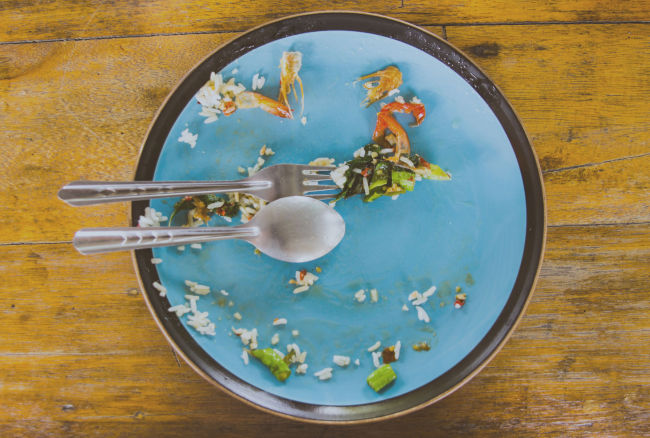Chuseok is usually a time of gluttony.
Meals during the Korean Thanksgiving holiday typically include copious amounts of the following: “jeon,” slices of vegetables, fish, or meat thinly coated in batter and grilled; “namul” or seasoned vegetables; “japchae,” vermicelli noodles with assorted vegetables and meat; and songpyeon or a type of traditional rice cake.
Overwhelmed with inevitable leftovers, Chuseok observers often let them go to waste by forgetting about them in the fridge, or even worse -- throwing them away.
Highway rest area employees report frequently finding leftover Chuseok food in trash cans.
Meals during the Korean Thanksgiving holiday typically include copious amounts of the following: “jeon,” slices of vegetables, fish, or meat thinly coated in batter and grilled; “namul” or seasoned vegetables; “japchae,” vermicelli noodles with assorted vegetables and meat; and songpyeon or a type of traditional rice cake.
Overwhelmed with inevitable leftovers, Chuseok observers often let them go to waste by forgetting about them in the fridge, or even worse -- throwing them away.
Highway rest area employees report frequently finding leftover Chuseok food in trash cans.

Every holiday season, Korea sees a significant jump in the number of unwanted items thoughtlessly tossed away along highways and roads, with typical trash ranging from cigarette butts to food, according to a Korean Express Corp. employee in an interview.
During the traffic-ridden Chuseok and Lunar New Year holidays, the amount of trash along highways and roads reaches approximately 20 tons per day. This represents a 50 to 60 percent increase in trash compared to other days of the year, according to figures released by the Korea Expressway Corp.
To help people manage and make the most of leftovers, Kim Byeong-jin, the executive chef at modern Korean restaurant Gaon, recommends the following recipes utilizing two Chuseok favorites: jeon and namul.
Jeongol with assorted jeon
Ingredients:
700 ml stew broth
50 g daikon used for anchovy broth
10 g green onion
10 g enoki mushroom
Assorted jeon
A few sprigs of garland chrysanthemum
A handful of sliced red or green chili
Stew broth
800 ml anchovy stock
20 g saeujeot (fermented shrimp)
20 g barley-based gochujang (red chili pepper paste)
10 g crushed garlic
5 g gochugaru (red chili powder)
5 ml of mirin
Anchovy stock
1.5 l water
100 g daikon
30 g dried whole anchovies
10 g dried seaweed
Directions:
Prepare the anchovy stock by boiling all the necessary ingredients in a pot. Once boiling, reduce the heat to low and boil for another 15 minutes.
Cut the boiled daikon used in the stock into thin, square slices.
Strain the stock and pour 800 ml of it back into the pot. Add the other ingredients for the stew broth and bring to boil.
After boiling for five minutes, strain the prepared broth.
Place the daikon slices and assorted jeon into the empty pot.
Pour back the broth, add in the rest of the ingredients, and slowly bring to a boil.
Taro-deulkkae soup
Ingredients:
720 ml beef stock
210 ml deulkkae extract
90 ml extract from glutinous rice
10 peeled taro roots
Assorted namul
Splash of perilla oil
Splash of soy sauce
Pinch of salt
Deulkkae (perilla seed) extract
200 ml water
100 g water-soaked perilla seeds
Extract from glutinous rice
100 ml water
50 g water-soaked glutinous rice
Directions:
To make deulkkae extract, soak 100 g of perilla seeds in water overnight, and then finely mix them in a blender with 200 ml of water. Strain using cheesecloth.
Similarly, after soaking 50 g of glutinous rice overnight, finely mix them in a blender with 100 ml of water to make the extract.
After peeling all of the taro roots, soak them in water used to rinse rice for an hour to eliminate their naturally sharp flavor.
Boil the soaked taro roots in a new batch of rice water until soft.
Lightly saute assorted namul with perilla oil in a pot. Add boiled taro roots and pour in the beef stock.
Bring the soup to a light boil and then add the two extracts. Bring the heat down low, and stir frequently.
Season with soy sauce and salt.
By Kim Yu-young (ivykim@heraldcorp.com)
-
Articles by Korea Herald


![[AtoZ into Korean mind] Humor in Korea: Navigating the line between what's funny and not](http://res.heraldm.com/phpwas/restmb_idxmake.php?idx=644&simg=/content/image/2024/04/22/20240422050642_0.jpg&u=)

![[Exclusive] Korean military set to ban iPhones over 'security' concerns](http://res.heraldm.com/phpwas/restmb_idxmake.php?idx=644&simg=/content/image/2024/04/23/20240423050599_0.jpg&u=20240423183955)

![[Herald Interview] Why Toss invited hackers to penetrate its system](http://res.heraldm.com/phpwas/restmb_idxmake.php?idx=644&simg=/content/image/2024/04/22/20240422050569_0.jpg&u=20240422150649)
![[Graphic News] 77% of young Koreans still financially dependent](http://res.heraldm.com/phpwas/restmb_idxmake.php?idx=644&simg=/content/image/2024/04/22/20240422050762_0.gif&u=)







![[Exclusive] Korean military to ban iPhones over security issues](http://res.heraldm.com/phpwas/restmb_idxmake.php?idx=652&simg=/content/image/2024/04/23/20240423050599_0.jpg&u=20240423183955)



![[Today’s K-pop] Ateez confirms US tour details](http://res.heraldm.com/phpwas/restmb_idxmake.php?idx=642&simg=/content/image/2024/04/23/20240423050700_0.jpg&u=)